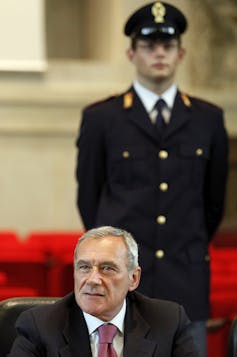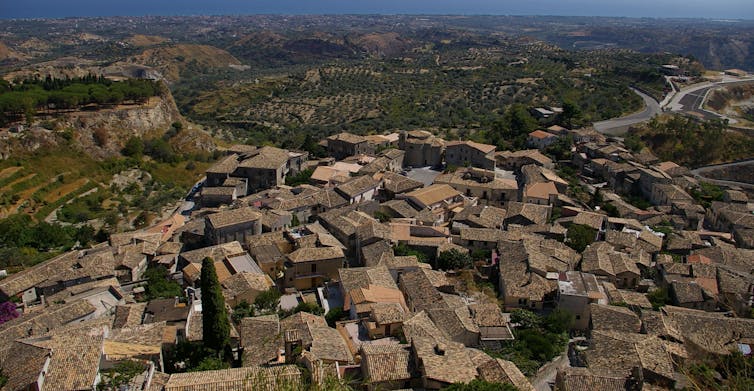The global war against mafias has a new number one enemy: the Calabrian ’Ndrangheta. At the centre of drug busts and manhunts throughout Europe and around the world, this mafia group from the deepest south of Italy seems to be everywhere. The ’Ndrangheta dominates the drug trade and shares business with El Chapo, all the while maintaining a constant presence in countries such as Germany, Switzerland, Australia, Canada and the United States.
Although it was only recently categorised as a mafia in Italian law in 2010, the ’Ndrangheta has been around for as long as its well-known sister group, the Sicilian Cosa Nostra. The name first entered the public consciousness during the 1980s and 90s, when the ’Ndrangheta carried out a series of kidnappings across Italy, in what was one of the bloodiest chapters of Calabrian history.
In August 2007, it stepped onto the global stage, when an internal feud led to the public murder of six Italians in Duisburg, Germany. By the end of the 2000s, the ’Ndrangheta was notorious around the world for operating a major trans-Atlantic cocaine ring.
The group’s singular name has Greek origins: the word “andranghateia” refers to a “society of men of honour”, and “andrangathō” means “to do military actions”. Like any other mafia, the ’Ndrangheta is highly secretive and operates within strict honour codes, which are deeply embedded in the societal values of Calabria. It has built a reputation on the violence of its feuds, the reliability of its business affiliates, its political influence and its global presence.
The ’Ndrangheta can move and settle in areas beyond the Calabrian region, and has a flexible, family-based, web-like structure, made up of various clans – much like Al-Qaeda. In this society, local roots count for as much as global reach.
A secret identity

Much of what we know about the ’Ndrangheta came to light in 2010, when Operation Crimine resulted in the arrest of 305 of its members. In the subsequent court trial, anti-mafia prosecutors proved that clans in the province of the Calabrian capital, Reggio Calabria, were coordinating with chambers of control in Canada, Australia and the north of Italy.
The family clans, known as ’ndrine, formed strategical alliances with each other, through blood or marriage ties, across villages in the area. Each ’ndrina then shared business with affiliates and family members, outside of the region or internationally, while simultaneously responding to local coordination structures (such as the “crimine” – the figure who is in charge of resolving issues and hostilities across the clans). Communication was mostly conducted in code over the phone but also online when necessary.
The revelation of these coordinating structures – which are primarily in place to help the ’Ndrangheta to boost business and share risks – has led many to think of ’Ndrangheta as a stable, monolithic criminal association, with a strong resemblance to the Sicilian Cosa Nostra.
A different picture
But details learned from other anti-mafia operations portray quite a different reality. In fact, the ‘ndrangheta is as fragmented as the region of Calabria itself. Scholars have talked about “Le Calabrie” (plural), to highlight how different parts of the region are politically, financially, industrially and socially diverse, and sometimes also geographically secluded.
Just as there are various “Calabrie”, so there are various “’Ndranghete”: similar to the ’Ndrangheta we learnt about through Operation Crimine, yet with important differences. While the clans are all territorial units, based on blood and family ties, they do not act together under a shared strategic plan.

Rather, they are often involved in different types of illegal activities: some local (the infiltration and extortion of the construction sector), and others global (the importation of cocaine from Latin America). All ’Ndrangheta clans have unique structures, which are either more or less centralised depending on which operations they undertake, their strength and their reach.
A powerful brand
In this sense, the name “’Ndrangheta” is more like a brand. It refers to both criminal organisations – like the one we heard about from Operation Crimine – but also to a set of behaviours, which are adopted by disparate criminal groups. In a process of “'ndranghetisation”, any group which exploits Calabria’s shared cultural values and relationships through the use of prevarication, arrogance, intimidation, violence, and subjection, while engaging in illegal activities for profit, can lay claim to the name.
For example, clans originating from villages in the hinterland near Reggio Calabria established themselves in Australia. From there, they can interact with ’Ndrangheta clans containing relatives in Canada, via Calabria, while also maintaining profitable relationships with local criminal groups, such as outlawed motorcycle gangs.
The fact is, the misconception of the ’Ndrangheta as a single organisation is likely to work to the advantage of such groups. By adopting these behaviours, they can invoke the ’Ndrangheta’s formidable international reputation to exploit weak political systems, invest in new ventures and grow. The versatility and prevalence of the ’Ndrangheta could also lead to innocent Calabrian migrants being incorrectly labelled as criminals. If authorities around the world are to put a stop to these activities, we must first understand the diverse and complex nature of the ’Ndrangheta.

